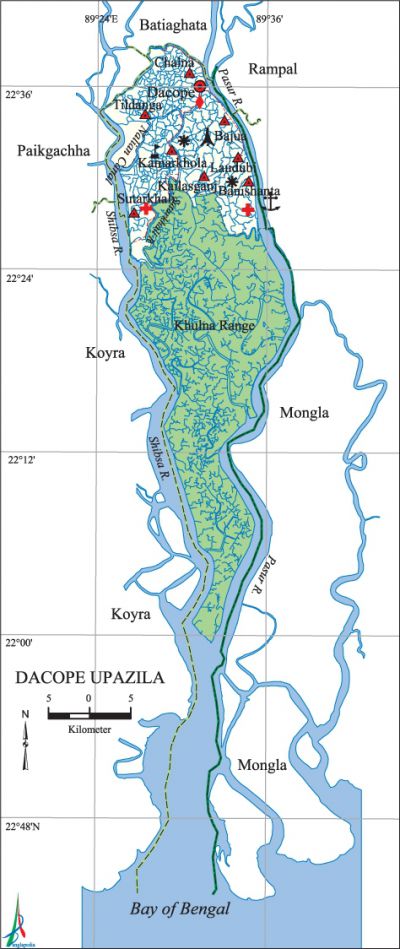Dacope Upazila
Dacope Upazila (khulna district) area 991.56 sq km, located in between 22°24' and 22°40' north latitudes and in between 89°24' and 89°35' east longitudes. It is bounded by batiaghata upazila on the north, pasur river on the south, rampal and mongla upazilas on the east, paikgachha and koyra upazilas on the west.
Population Total 152316; male 76291, female 76025; Muslim 63334, Hindu 86113 and Christian 2869.
Water bodies Main rivers: Pasur, shibsa, Manki, bhadra; Palashbari, Churia, Nalian and Jugra canals are notable.
Administration Dacope Thana was formed on 10 February 1906 and it was turned into an upazila in 1983.
| Upazila | ||||||||
| Municipality | Union | Mouza | Village | Population | Density (per sq km) | Literacy rate (%) | ||
| Urban | Rural | Urban | Rural | |||||
| 1 | 9 | 26 | 97 | 14188 | 138128 | 154 | 64.5 | 55.1 |
| Municipality | ||||||||
| Area (sq km) |
Ward | Mahalla | Population | Density (per sq km) |
Literacy rate (%) | |||
| 9.49 | 9 | 15 | 14188 | 1495 | 64.5 | |||
| Union | ||||
| Name of union and GO code | Area (acre) | Population | Literacy rate (%) | |
| Male | Female | |||
| Kamarkhola 63 | 10214 | 7103 | 6794 | 58.1 |
| Kailasganj 52 | 7744 | 7173 | 7343 | 61.5 |
| Tildanga 84 | 24526 | 8359 | 8647 | 60.0 |
| Dacope 42 | 4329 | 3534 | 3513 | 65.6 |
| Bajua 10 | 14054 | 7909 | 7844 | 50.5 |
| Banishanta 13 | 56749 | 7291 | 7315 | 47.6 |
| Laudubi 21 | 3613 | 4569 | 4653 | 58.5 |
| Sutarkhali 73 | 112059 | 15205 | 14855 | 49.5 |
| Pankhali 69 | 9099 | 7637 | 7933 | 56.5 |
Source Bangladesh Population Census 2011, Bangladesh Bureau of Statistics.

War of Liberation Freedom fighters had an encounter with razakars at Chalna Bazar area of the upazila and although there had been no other dierect fight with Pak army in the Upazila, freedom fighters attacked a warship of the Pak army at a place near Banishanata in between Mongla port and Dacope and had destroyed it. Freedom fighters also carried out an operation at Khatail-Lakshmikhola. A mass killing site has been discovered at Bajua High School courtyard; a memorial monument (Smriti Amlan) was built at the premises of the Dacope municipality office.
For details: see দাকোপ উপজেলা, বাংলাদেশ মুক্তিযুদ্ধ জ্ঞানকোষ (Encyclopedia of Bangladesh War of Liberation Bangla Version), বাংলাদেশ এশিয়াটিক সোসাইটি, ঢাকা ২০২০, খণ্ড ৪।
Religious institutions Mosque 72, temple 137, church 11, sacred place 2.'
Literacy rate and educational institutions Average literacy 56.0%; male 62.9%, female 49.1%. Educational institutions: college 6, secondary school 31, primary school 56, NGO school 43, madrasa 5. Noted educational institutions: Surendranath College (1972), Chalna MM College (1984), Sreenagar ME Secondary School (1817), Bajua Union High School (1920), Chalna Government KC Primary School (1947), Bajua Government Primary School (1947).
Newspapers and periodicals Alochhaya, Barsa, Padakkep, Prayas.
Cultural organisations Club 40, library 2, theatre group 1, opera party 1, women's organisation 1.
Special attractions The sundarbans (located on the southern part of the upazila), Crocodile breeding centre, Watch Tower.
Main sources of income Agriculture 66.07%, non-agricultural labourer 4.85%, commerce 12.86%, transport and communication 1.72%, service 4.10%, construction 0.93%, religious service 0.24%, rent and remittance 0.05% and others 9.18%.
Ownership of agricultural land Landowner 55.02%, landless 44.98%; agricultural landowner: urban 42.04% and rural 57.06%.
Main crops Paddy, potato, pumpkin, vegetables.
Extinct or nearly extinct crops Jute, sesame, aush and boro paddy.
Main fruits Coconut, guava, plum, sofeda, bangi, watermelon.
Fisheries, dairies and poultries In this upazila shrimp cultivation are done in an extended form.
Communication facilities Roads: pucca 29 km, semi-pucca 385 km, mud road 1355 km; waterway 5 km.
Extinct or nearly extinct traditional transport Palanquin, bullock cart, horse carriage.
Noted manufactories Fish processing factory, rice mill, salt production centre.
Cottage industries Goldsmith, blacksmith, potteries, bamboo work, cane work.
Noted hats, bazars and fairs' Chalna Hat, Bajua Hat, Pankhali Hat, Poddarganj Hat, Bajua Bijoya Dashmir Mela, Baruni Mela and Mela on the occasion of the birth celebration of Sri Sri Anukul Chandra.
Main exports Frozen shrimp and crab.
Access to electricity All the unions of the upazila are under rural electrification net-work. However 28.2% dwellings have access to electricity.
Sources of drinking water Tube-well 30.6%, tap 0.7% and others 68.7%.
Sanitation 67.3% of dwelling households of the upazila use sanitary latrines and 18.9% of dwelling households use non-sanitary latrines; 13.8% of households do not have latrine facilities.
Health centres Hospital 1, family welfare centre 3, health and family planning centre 9, mother and child welfare centre 1.
NGO activities proshika, World Vision, Gonoshahajjo Sangstha, HEED Bangladesh, brac, Step, Prodipon, Vost, ESDO. [Shah Siddiqi]
References Bangladesh Population Census 2001 and 2011, Bangladesh Bureau of Statistics; Cultural survey report of Dacope Upazila 2007.
